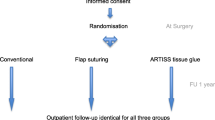Abstract
Formation of seroma most frequently occurs after mastectomy and axillary surgery. This study is intended at creating data on whether flap fixation has any role in reducing the seroma formation in patients undergoing the modified radical mastectomy. A prospective comparative study was conducted among 61 patients scheduled for modified radical mastectomy from 1st of January 2017 to 31st of December 2017. Patients were divided into two groups. In the flap fixation group (N = 30), the skin flaps were sutured to the pectoral muscle with Vicryl 3–0 sutures, and in the control group (N = 31), the wound was closed in the conventional methods at the edges. Closed suction drain was used in both groups. Flap fixation group showed a significantly lower frequency of seroma formation compared with the control group. In the flap fixation group, the drain was removed earlier compared with the control group. Mean value of the total amount of fluid drained for the study group was significantly lower than that of control. Flap fixation is a surgical technique which appears to reduce the total volume of fluid drained, the development of seroma, and the need for seroma aspirations.


Similar content being viewed by others
Abbreviations
- MRM:
-
modified radical mastectomy
- SSI:
-
surgical site infection
References
Vettuparambil A, Rajan G, Chirukandath R, Culas TB (2015) Epidemiology, pathological characteristics and estrogen and progesterone receptor status of operated cases of female breast cancer: a retrospective review of 266 cases from Kerala. Indian J Surg Oncol 6(4):352–355
SEER-Stat database. http://seer.cancer.gov/statfacts/html/breast.html
Kumar S, Lal B, Misra MC (1995) Post-mastectomy seroma: a new look into the aetiology of an old problem. J R Coll Surg Edinb 40:292–294
Gonzalez EA, Saltzstein EC, Riedner CS, Nelson BK (2003) Seroma formation following breast cancer surgery. Breast J 9:385–388
Leong SP, Shen ZZ, Liu TJ, Agarwal G, Tajima T, Paik NS, Sandelin K, Derossis A, Cody H, Foulkes WD (2010) Is breast cancer the same disease in Asian and Western countries? World J Surg 34(10):2308–2324
Oertli D, Laffer U, Haberthuer F, Kreuter U, Harder F (1994) Perioperative and postoperative tranexamic acid reduces the local wound complication rate after surgery for breast cancer. Br J Surg 81:856–859
Petrek J, Peters M, Nori S, Knauer C, Kinne D, Rogatko A (1990) Axillary lymphadenectomy. A prospective, randomized trial of factors influencing drainage, including early or delayed arm mobilization. Arch Surg 125:378–382
Hashemi E, Kaviani A, Najafi M, Ebrahimi M, Hooshmand H, Montazeri A (2004) Seroma formation after surgery for breast cancer. World J Surg Oncol 2:44
Coveney EC, O’Dwyer PJ, Geraghty JG, O’Higgins NJ (1993) Effect of closing dead space on seroma formation after mastectomy - a prospective randomized clinical trial. Eur J Surg Oncol 19:143–146
Purushotham AD, McLatchie E, Young D, George WD, Stallard S, Doughty J, Brown DC, Farish C, Walker A, Millar K, Murray G (2002) Randomized clinical trial of no wound drains and early discharge in the treatment of women with breast cancer. Br J Surg 89:286–292
Hamy A (1990) Wading of the axilla in conservative treatment of cancer of the breast. J Chir 127:99–102
Chilson TR, Chan FD, Lonser RR, Wu TM, Aitken DR (1992) Seroma prevention after modified radical mastectomy. Am Surg 58:750–754
O’Dwyer PJ, O’Higgins NJ, James AG (1991) Effect of closing dead space on incidence of seroma after mastectomy. Surg Gynecol Obstet 172:55–56
Schuijtvlot M, Sahu AK, Cawthorn SJ (2002) A prospective audit of the use of a buttress suture to reduce seroma formation following axillary node dissection without drains. Breast 11:94–96
Jansen RF, van Geel AN, de Groot HG et al (1990) Immediate versus delayed shoulder exercises after axillary lymph node dissection. Am J Surg 160:481–484
Abe M, Iwase T, Takeuchi T, Murai H, Miura S (1998) A randomized controlled trial on the prevention of seroma after partial or total mastectomy and axillary lymph node dissection. Breast Cancer 5:67–69
O’Hea BJ, Ho MN, Petrek JA (1999) External compression dressing versus standard dressing after axillary lymphadenectomy. Am J Surg 177:450–453
Chen CY, Hoe AL, Wong CY (1998) The effect of a pressure garment on post-surgical drainage and seroma formation in breast cancer patients. Singap Med J 39:412–415
Bonnema J, van Geel AN, Ligtenstein DA, Schmitz PI, Wiggers TA (1997) Prospective randomized trial of high versus low vacuum drainage after axillary dissection for breast cancer. Am J Surg 173:76–79
Moore M, Burak W, Nelson E, Kearney T, Simmons R et al (2001) Fibrin sealant reduces the duration and amount of fluid drainage after axillary dissection. J Am Coll Surg 192:591–599
Carcoforo P, Soliani G, Maestroni U, Donini A, Inderbitzin D et al (2003) Octreotide in the treatment of lymphorrhea after axillary node dissection: a prospective randomized controlled trial. J Am Coll Surg 196:365–369
Porter KA, O’Connor S, Rimm E, Lopez M (1998) Electrocautery as a factor in seroma formation following mastectomy. Am J Surg 176:8–11
Acknowledgments
We acknowledge the help and support of Dr. Dinesh H N, Professor and Head of the Dept. of General Surgery, and Dr. Madhu B S, Professor of General Surgery, for completing this study.
Author information
Authors and Affiliations
Corresponding author
Ethics declarations
Competing Interests
The authors declare that they have no conflict of interest.
Additional information
Publisher’s Note
Springer Nature remains neutral with regard to jurisdictional claims in published maps and institutional affiliations.
Rights and permissions
About this article
Cite this article
Vettuparambil, A., Subramanya, C. Flap Fixation as a Technique for Reducing Seroma Formation in Patients Undergoing Modified Radical Mastectomy: an Institutional Experience. Indian J Surg Oncol 12, 48–53 (2021). https://doi.org/10.1007/s13193-020-01220-5
Received:
Accepted:
Published:
Issue Date:
DOI: https://doi.org/10.1007/s13193-020-01220-5




